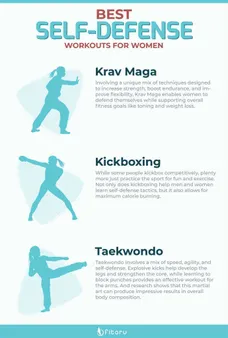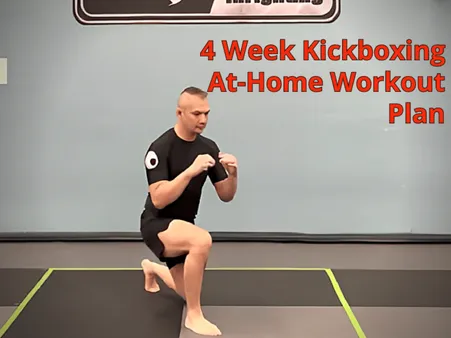Table of Contents
In today's world, learning self-defense is more important than ever. Kickboxing is a great way to get in shape, learn practical self-defense skills, and relieve stress. At Kizworld, we believe that everyone should have the opportunity to learn how to protect themselves. That's why we've created this comprehensive guide on How to learn kickboxing for self-defense and fitness. Whether you're a complete beginner or looking to improve your skills, this guide has everything you need to get started on your kickboxing journey.
How to Learn Kickboxing for Self-Defense and Fitness: A Comprehensive Guide
I. Kickboxing for Self-Defense: Techniques and Strategies
Kickboxing for Self-Defense: Techniques and Strategies
Footwork and Movement
- Maintain a stable stance with weight evenly distributed on both feet.
- Keep your feet shoulder-width apart and slightly turned out.
- Move quickly and smoothly, using short, quick steps.
Basic Kicks
- Front kick: A straight kick with the ball of your foot.
- Roundhouse kick: A circular kick with the ball of your foot.
- Side kick: A kick with the side of your foot.
- Back kick: A kick with the heel of your foot.
Discover the mind and body benefits of martial arts.
Basic Punches
- Jab: A straight punch with your lead hand.
- Cross: A straight punch with your rear hand.
- Hook: A curved punch with your lead hand.
- Uppercut: A rising punch with your rear hand.
Explore the essential gear and equipment for martial arts.
Combinations
Combine basic punches and kicks to create powerful combinations.
Learn techniques to enhance your skills in martial arts.
Defense Techniques
- Blocking: Use your arms, legs, and body to block attacks.
- Dodging: Move your body out of the way of attacks.
- Countering: Attack your opponent immediately after they attack you.
Find tips and advice on preventing and treating martial arts injuries.
Sparring
Practice your skills against a partner in a controlled environment.
Safety precautions
- Always warm up before training.
- Use proper safety gear, such as gloves, pads, and a mouthguard.
- Listen to your body and take breaks when you need them.
- Train with a qualified instructor.
Discover key factors to consider when choosing a martial arts school and instructor.
II. Kickboxing for Fitness: A Full-Body Workout
Kickboxing for Fitness: A Full-Body Workout
Kickboxing is a great way to get in shape, relieve stress, and learn self-defense. It combines elements of karate, boxing, and Muay Thai, making it a dynamic and effective form of exercise.
Kickboxing for fitness provides a full-body workout that engages all major muscle groups. The punches, kicks, and footwork involved in kickboxing help to strengthen the arms, legs, and core. Additionally, the constant movement and coordination required during kickboxing classes improve balance, agility, and cardiovascular health.
Benefits of Kickboxing for Fitness | Specific Exercises and Techniques |
|---|---|
Burns Calories: Kickboxing is a high-intensity workout that can help you burn up to 800 calories per hour. | Practice basic kicks such as the front kick, roundhouse kick, and side kick. Master punches like the jab, cross, and hook. |
Builds Muscle: Kickboxing helps to develop lean muscle mass, which can improve your strength and metabolism. | Work on combinations that involve punches and kicks, such as the jab-cross-roundhouse kick. Incorporate footwork drills to improve your coordination and agility. |
Improves Cardiovascular Health: The constant movement and high-intensity nature of kickboxing help to strengthen your heart and lungs. | Practice heavy bag workouts to build power and endurance. Engage in pad work with a partner to improve your timing and accuracy. |
Kickboxing is a challenging but rewarding workout that can help you achieve your fitness goals. If you're looking for a fun and effective way to get in shape, kickboxing is a great option.
Related Posts:
- Benefits of Boxing for Physical and Mental Health
- How to Choose the Right Boxing Gym and Trainer
- How to Learn the Basic Boxing Skills and Techniques
III. Advanced Kickboxing Techniques
Once you've mastered the basics of kickboxing, you can start to learn more advanced techniques. These techniques can help you to improve your power, speed, and accuracy.
- Spinning Back Kick: A powerful kick that is thrown with the heel while spinning your body.
- Jumping Side Kick: A quick and agile kick that is thrown while jumping.
- Flying Knee Strike: A devastating strike that is thrown while jumping and bringing your knee up to the opponent's head.
- Elbow Strike: A sharp strike that is thrown with the elbow.
- Head Kick: A high-risk, high-reward kick that is thrown to the opponent's head.
These are just a few of the many advanced kickboxing techniques that you can learn. As you progress in your training, you'll be able to add these techniques to your arsenal and become a more well-rounded kickboxer.
Related Posts:
- Top Boxing Competitions and Events
- Most Famous Boxers and Champions of All Time
- How to Train Like a Boxer
IV. Benefits of Kickboxing: Physical and Mental
Benefits of Kickboxing: Physical and Mental
Kickboxing is a martial art that combines elements of karate, boxing, and Muay Thai. It's a great way to get in shape, learn self-defense, and relieve stress. Whether you're a complete beginner or looking to improve your skills, kickboxing has something to offer everyone.
There are many physical benefits to kickboxing. It's a great way to burn calories and lose weight. Kickboxing also helps to improve your cardiovascular health, strength, and flexibility. It can also help to reduce stress and improve your mood.
- Improved cardiovascular health
- Increased strength and flexibility
- Reduced stress and improved mood
- Weight loss
- Improved coordination and balance
- Enhanced self-confidence
In addition to the physical benefits, kickboxing also has a number of mental benefits. It can help to improve your focus, concentration, and discipline. Kickboxing can also help to boost your self-confidence and self-esteem. It's a great way to learn how to defend yourself and to feel more empowered.
If you're looking for a martial art that is both physically and mentally challenging, kickboxing is a great option. It's a fun and rewarding way to get in shape, learn self-defense, and improve your overall well-being.
Here are some tips for getting started with kickboxing:
- Find a reputable kickboxing gym or instructor.
- Start slowly and gradually increase the intensity of your workouts.
- Focus on proper technique to avoid injury.
- Listen to your body and take breaks when you need them.
- Have fun and enjoy the process!
If you're interested in learning more about kickboxing, check out our article on How to Learn Kickboxing for Self-Defense and Fitness.
V. Getting Started with Kickboxing: Tips for Beginners
Getting Started with Kickboxing: Tips for Beginners
Kickboxing is a great way to get in shape, learn self-defense, and relieve stress. It's also a challenging and rewarding workout that can help you build confidence and improve your overall fitness. If you're new to kickboxing, there are a few things you can do to get started and make the most of your experience.
- Find a reputable kickboxing gym or instructor.
- Start with a beginner's class.
- Learn the basic techniques of kickboxing.
- Work on your cardio and strength training.
- Spar with other students.
- Compete in kickboxing tournaments.
One of the most important things you can do when starting out is to find a reputable kickboxing gym or instructor. Do some research online or ask for recommendations from friends or family members. Once you've found a few gyms or instructors that you're interested in, go for a visit and try out a class. Pay attention to the quality of the instruction, the safety of the gym, and the atmosphere. Choose a gym or instructor that you feel comfortable with and that you think you can learn from.
Once you've found a gym or instructor, it's time to start training. Beginner's classes are a great way to learn the basics of kickboxing. These classes will teach you the proper stances, punches, kicks, and combinations. You'll also learn how to defend yourself against common attacks.
As you progress in your training, you'll need to start working on your cardio and strength training. Cardio is important for building endurance, while strength training is important for building power and speed. You can do both of these things at home or at the gym. There are many different cardio and strength training exercises that you can do, so find some that you enjoy and that challenge you.
Sparring is an important part of kickboxing training. Sparring allows you to practice your techniques against a live opponent and to learn how to deal with different situations. Sparring can also help you improve your reaction time, coordination, and balance. When you spar, it's important to wear protective gear, such as a helmet, gloves, and mouthguard.
If you're interested in competing in kickboxing tournaments, you'll need to start training specifically for competition. This means working on your speed, power, and endurance. You'll also need to learn how to fight in a ring and how to deal with the pressure of competition. Competing in kickboxing tournaments can be a great way to test your skills and to challenge yourself. However, it's important to remember that competition is not for everyone. If you're not interested in competing, you can still enjoy kickboxing as a recreational activity.
Here are some additional tips for getting started with kickboxing:
- Set realistic goals for yourself.
- Don't be afraid to ask questions.
- Be patient and persistent.
- Have fun!
Kickboxing is a great way to get in shape, learn self-defense, and relieve stress. If you're looking for a challenging and rewarding workout, kickboxing is a great option. Just remember to start slowly, work hard, and have fun.
Equipment | Description | Where to Buy |
Punching Bag | A heavy bag used for practicing punches and kicks. | Sporting goods stores or online retailers |
Hand Wraps | Wraps that protect the hands and wrists during training. | Sporting goods stores or online retailers |
Boxing Gloves | Gloves that protect the hands and knuckles during sparring. | Sporting goods stores or online retailers |
Mouthguard | A guard that protects the teeth and mouth during sparring. | Sporting goods stores or online retailers |
Shin Guards | Pads that protect the shins during kicks. | Sporting goods stores or online retailers |
Related articles:
- How to Learn Kickboxing for Self-Defense and Fitness
- The Benefits of Kickboxing for Physical and Mental Health
- The Best Kickboxing Equipment and Gear
VI. Conclusion
Kickboxing is a versatile martial art that offers a wide range of benefits for both self-defense and fitness. Whether you're a beginner or an experienced martial artist, kickboxing can help you improve your strength, speed, agility, and coordination. It can also help you learn valuable self-defense skills that can help you stay safe in dangerous situations. If you're looking for a challenging and rewarding workout that can help you get in shape and learn practical self-defense skills, kickboxing is a great option. So, what are you waiting for? Find a kickboxing class near you and get started today!